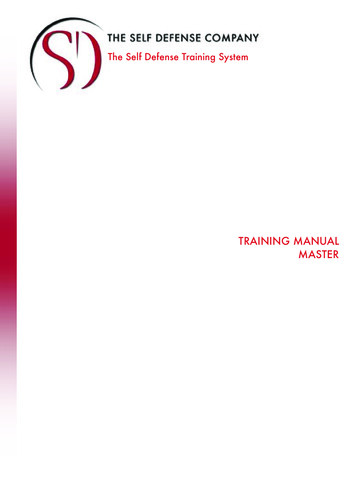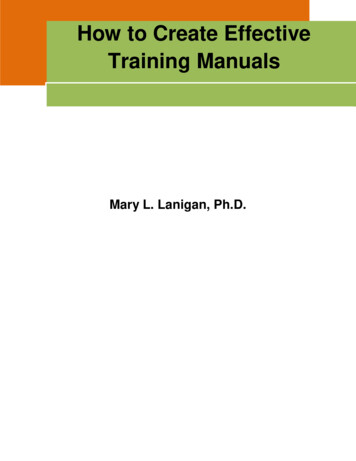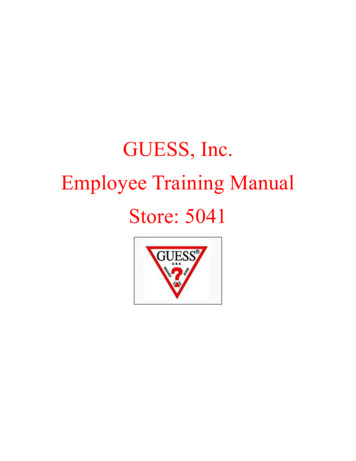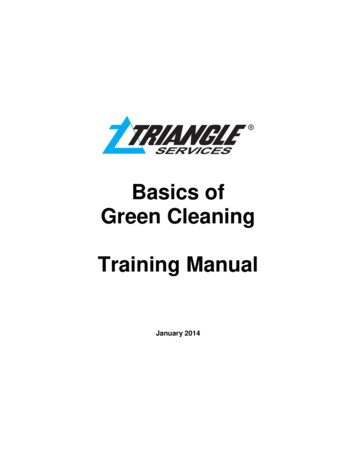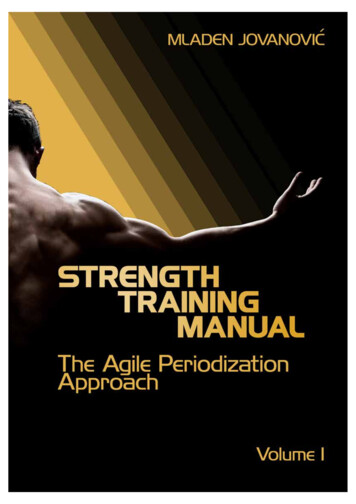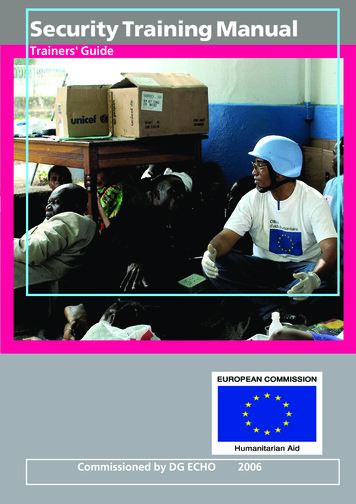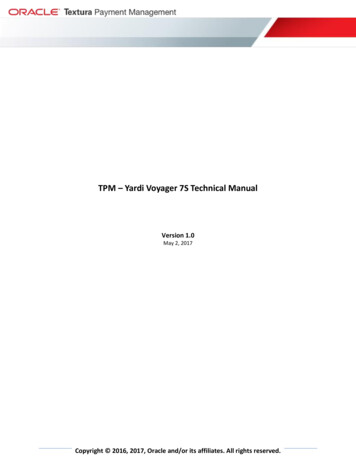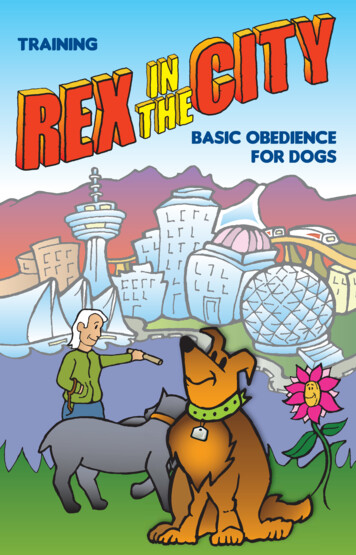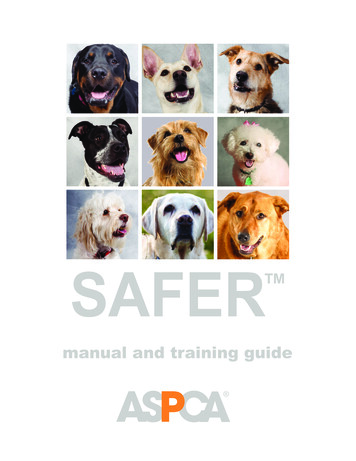
Transcription
manual and training guide
forwardIn 2007, the American Society for the Prevention of Cruelty to Animals (ASPCA ) acquiredSAFER (Safety Assessment for Evaluating Rehoming).The ASPCA invites you to learn about the program which will help you to better know the dogsin your care, by identifying which dogs in your shelter or rescue group are ready to go into yourplacement program, which ones will benefit from behavior modification and which ones will needcareful management if they are to be placed. The heart of the SAFER program is an aggressionassessment tool designed by Emily Weiss, Ph.D., CAAB, for the Kansas Humane Society in Wichita.In 1999, Kansas Humane Society approached Dr. Weiss to develop an aggression assessmentthat could identify safe, adoptable dogs which would be short, accurate and cost little to implement— concerns shared by most shelter organizations. Initially, SAFER was a six-item assessmentwhich could be completed in less than six minutes utilizing an Assessor and an Observer, shelterstaff who were knowledgeable about dog behavior and possessed excellent observation and safeanimal handling skills. Since its inception, a seventh item has been added — toy behavior — so theassessment now takes a couple of minutes longer per dog.Beyond the addition of a seventh assessment item, the SAFER program has grown in other ways.During her work with Southern and Midwestern shelters taking part in the Rescue Waggin’ AnimalTransport Program sponsored by PetSmart Charities and the ASPCA, Dr. Weiss came to realizethe importance of Assessor Certification, to ensure that SAFER Assessors were all consistent intheir execution of the program. (See SAFER Certification chapter for more information.) Throughher shelter intern program, behavior modification protocols for common behavior issues such as foodbowl aggression and touch-sensitivity have been tested and modified and are now available so thatafter those problems are identified in the assessment, shelter behavior staffers can take action.While SAFER is the first tool developed by Dr. Emily Weiss, MYM Canine-ality was subsequentlydesigned by going beyond an aggression assessment to help best match individual dogs withadopters’ lifestyles and expectations. Dr. Emily Weiss also researched and developed othermatch-making programs for puppies and cats, Puppy-ality and Feline-ality , respectively.To learn more about the ASPCA’s SAFER and Meet Your Match programs, visit www.ASPCApro.org.2
contents4introduction7research11 who should assess13 using the SAFER assessment – an overview15 facility requirements and equipment19 the SAFER assessment item by item37 utilizing the SAFER worksheet41 role of the observer43 SAFER certification47 behavior modification and management protocols65 glossary69 reproducible forms and templates3
introductionASPCA SAFER guideASPCA SAFER is a seven item aggressionassessment that identifies the dog’s comfort levelwith restraint and touch, reaction to new experiencesincluding movement and sound stimuli, bite inhibition,behavior around food and toys, and arousal leveltoward other dogs. The dog’s behavioral response tothese assessment items and the organization’sStandard Operating Procedures (SOP) determine thenext steps to be taken with the dog.why utilize an aggression assessmentShelters that employ SAFER or other researchbased behavior assessments report feweraggression complaints, more adoptions, and betterclient interactions. Simply put, they are able to moreaccurately communicate to the adopter about whatthey should expect, and how to best manage, a dogin their home.SAFER demands staff time, facility spaceand a passel of supplies; and at times, it can raisecontroversy. Why should shelters assess their dogs?Short answer: it’s the prudent thing to do. A prudentshelter is one that employs good judgment andcommon sense. It is prudent to have a validatedscientific tool to back up that “gut feeling” that thedog identified as good with kids and first-time petguardians has the highest probability to be a safechoice for them. It is prudent to determine whichdogs will flourish when given some behaviormodification for the quirks and foibles identifiedby the assessment. It is prudent to put in place aconsistent assessment procedure when determiningwhich dogs are most likely to be a danger to staff,volunteers, potential adopters and the community atlarge, so that next-step discussions will center aroundwhat to do with the dog, not around what was doneto the dog. These are the reasons to find the stafftime and spend the money necessary to employ anaggression assessment. In an age where lawsuitsare common and insurers are scarce, not to do sowould be imprudent.4Shelters that employSAFER or otherresearch-based behaviorassessments report feweraggression complaints,more adoptions, and betterclient interactions.what the scoring meansWhen a dog scores “1s” and “2s” on his assessment,he is less likely to bite under ordinary living situationswhen handled in a mildly stressful or moderatelyawkward manner than dogs who score “3s,” “4s” and“5s.” Dogs that score “3s” may be safe and inhibittheir bite, but they could be made safer by puttingthem on a behavior modification program. Dogs thatscore “4s” may have serious fear or intolerance issuesand should either receive behavior modificationtraining and then be reassessed or only be adoptedout to experienced adopters ready to manage thedog’s issues. Dogs whose behavior during one of thefirst four assessment items score a “5” have the
highest probability to be a serious danger to staff,volunteers and visitors to the facility. (See Researchpages 7–10 for more information.) They should onlybe handled by the shelter’s most experienced staffuntil their disposition is determined. These dogs mayrespond well to behavior modification or they may not.determining next stepsOnce a dog is assessed and his behavior responsesnoted, the assessment team should review hisworksheet. If any of the canine behaviors displayedwere reason for concern, the team should first reviewthe assessment video to ensure there was nothingimproper in the way the assessment was conductedor the way the dog was handled that attributed tothe dog’s particular response. If all was done by thebook, the dog’s assessment should be brought tothe attention of the Animal Behavior or Animal CareSupervisor to determine next steps. As each shelteris unique and has different resources available, nextsteps will vary from shelter-to-shelter.Or your facility may be an overcrowded, highvolume, open access animal care and controlwith few resources and no Friends of the Sheltergroup. Your shelter may not even be able to assessevery dog over six months of age. In this case,SAFER might only be used to help identify thebehaviorally soundest pit bulls and guarding breedsto insure that those placed up for adoptionwill be great ambassadors for both their breedsand your shelter.The SAFER assessment may help supervisorsmake euthanasia decisions, but the assessmentalone should never be the only input considered.Relinquishment surveys done at intake, veterinaryreports from the health check, and input from animalcare technicians, volunteers, and foster parentsshould also be considered whenever a lifeor death decision must be made.If staff and cage space is available, the dog mightbe given another twenty-four hours to settle intohis surroundings and then be re-assessed. If theshelter employs a behavior staff, the dog maybe put on a behavior modification program andre-assessed after the program is complete. Someshelters have behavior foster homes in which tohouse dogs with potential behavior issues for a trialperiod. Experienced foster volunteers would followthrough with the shelter’s behavior modificationprogram and observe the dog’s behavior in a “reallife” setting. Shelters without behavior departmentsmay utilize community dog trainers to either deviseadditional behavior modification protocols, workwith the shelter dogs or serve as behavior fosterhomes — paid or unpaid. A local rescue groupmay be interested in taking the dog. Sharing theassessment with the group allows them to make aninformed decision about whether or not they have theresources to meet the animal’s needs.5
6
research7
identifying aggressionOne focus of Dr. Emily Weiss’ graduate careerwas on the selection of service dogs from shelters.Her research, which was conducted at the KansasHumane Society of Wichita (KHS), focusedspecifically on developing a set of assessmentitems that would better predict service dog potentialin dogs selected from shelters. This work waspublished in The Journal of Applied AnimalBehaviour and the Journal of Applied AnimalWelfare Science (1997, 2002). During the datacollection period, the KHS expressed an interestin having a research-based assessment to helpidentify potential aggression. They had a highnumber of reports of aggression about their adopteddogs. Several of the assessment items researchedfor the service dog work focused on arousal, fear,and other potential issues, making a good basefor a potential aggression assessment.SAFER was developed based on the needsand resources of the Kansas Humane Society ofWichita (KHS). The open admission facility was, likemost facilities, short staffed. The time allotted for anassessment was about six minutes per dog. Itemsfrom the earlier research were added to a foodaggression assessment that was already availablefor shelter use (Assess-a-Pet , Sue Sternberg). Staffwas trained on the assessment process and then thesix item assessment was tested on a sample of dogs.The sample was derived from dogs entering KHS.All dogs were randomly assigned a number as theyentered the facility. If the number was odd, the dogwas placed in Group 1, if the number was even, thedog was placed in Group 2. All dogs that enteredwithout a bite report and were considered by thefacility to be healthy were included in the study.group 1:These dogs were assessed using SAFER and received “1s” and “2s” on the assessment.group 2:These dogs were not assessed. They weregiven a thorough health exam; and if theyaggressed during the exam, they were notincluded in the study.There were a total of 141 dogs in the sample:66 in Group 1, and 75 in Group 2. The groupsare not equal due to issues beyond the study’scontrol (illness, overcrowding etc.).8researchResults of the study were encouraging.Note: At the time of the research, KHS wasstruggling (as many facilities do) with too manyanimals and not enough resources to support them.They very often needed to euthanize for space.During the study period, seven of the study dogswere euthanized for space — those with the longeststay (by the hour and minute) pulled. Eight dogswere euthanized for health reasons. Twelve dogswere euthanized for behavior reasons — eight fromGroup 2 and four from Group 1.22 dogs were adopted and returned (no aggressionreported in returns)91 dogs were adoptedAdopters were called after the dogs were in theirhomes for more than two weeks and were asked aseries of questions regarding observed aggression.adopter reports on aggressionobserved in the ession15aggressionaround toys25growling ata human110Replication of data in different environments isone way to prove the strength of an experiment.To this end, a similar study of SAFER wasrecently conducted at the County of RiversideDepartment of Animal Services (Riverside, CA)comparing 50 assessed and 50 unassessed dogs.Adopters reported incidents of growling in 14 of theunassessed dogs and only three of the assesseddogs; five of the unassessed and one assessed dogbit but did not break the skin; and two unassesseddogs bit someone and broke the skin.
consistency between assessorsand assessment centersIt is important that Assessors are trained to remainobjective and to accurately report the behavior theyobserve during the assessment. Provided nointervention has occurred, ideally dogs shouldrespond the same when an assessment is repeatedeven if a different trained Assessor conducts thesecond assessment, and even if the secondassessment occurs in a different environment.Testing this consistency with a large population ofdogs would have been difficult. However, SAFER was used by PetSmart Charities’ Rescue Waggin’ transport program. This program, which at the timeof publication has saved over 15,000 dogs, bringsdogs from areas with low live release rates ofbehaviorally healthy dogs to shelters with very highadoption rates. This has given us the opportunity tomore fully explore whether SAFER is likely toconsistently produce the same results over time,and with different Assessors as assessments aredone at both source and receiving shelters.When the transport program began, Assessors atboth source and receiving shelters were trained,but there was no certification program to check theability of individuals to accurately assess the dogs.Receiving shelters were reporting a high number oftransported dogs with significant behavior issues.These dogs require more resources, and often takelonger to be adopted. Since the receiving sheltersneeded to save their resources for the at risk dogsin their own communities, devising a method todecrease the likelihood of transporting dogs withWhen the transportprogram began,assessors at bothsource and receivingshelters were trained,but there was nocertification programto check the ability ofindividuals to accuratelyassess the dogs.significant behavior issues was necessary. Thesolution was to certify individuals assessing forthe Rescue Waggin’ program to ensure that allAssessors have the skills to conduct and scorecorrectly. Certification involves sending a tapeof the individual assessing three dogs in theirfacility. Approximately 55% of those who submitare certified on their first attempt. Once certificationwas put in place, we assessed the program. Wefollowed 3,000 dogs in the Rescue Waggin’ program from source shelter to receiving shelter,and only 3% of the dogs scored differently at thereceiving facility than they did at the source facility.SAFER as an intake toolMany facilities can benefit from an assessmenttool that can help identify safety at intake. Theuse of SAFER at intake was originally researchedat the Wisconsin Humane Society. Forty-oneowner-relinquished dogs were assessed at intake.Twenty-one of the dogs scored “1s” and “2s” onthe assessment at intake. Of those, eighteen ofthose scored “1s” and “2s” when assessed afterstaying in the facility approximately 24-72 hours.In other words, 86% of the dogs that scored “1s”and “2s” at intake scored the same after beinghoused in the facility for 1-3 days.Twenty dogs scored at least one 3, 4 or 5. Thesedogs were also then housed in the shelter for 1-3days and then reassessed. Two-thirds of these dogsscored the same after being housed in the shelter,while one third had either a decreased level ofpotential aggression, or a behavior (such as foodaggression) that was easily modifiable.research9
supporting dogs with identifiedbehavior challengesOne of the most exciting areas of research with theSAFER program has been the investigation ofbehavior modification and management programsfor dogs in which potentially aggressive behaviorhas been noted. We continue to build support forthese dogs, and do so by researching theeffectiveness of particular programs.Food guarding is a very common behavior issuein shelter dogs. We define food guarding as whena dog aggresses over food items, and not overtoys or other non-food items. Working with theWisconsin Humane Society, Dr. Weiss developed asimple in-shelter and in-home behavior modificationplan (see Reproducible Forms and Templatessection for details) for dogs displaying foodaggression during the SAFER assessment.Criteria for subject selection was as follows: Alldogs had to be over six months of age; scored “1s”and “2s” on all other parts of SAFER other thanfood behavior; the dogs could not leave the fooditem to aggress, aggression was only toward fooditems; no behaviors suggesting possessionaggression were present. Bully breeds were notchosen for this study.All dogs that met the criteria during the studyperiod were placed on the food guarding programto eliminate the behavior before being placed onthe adoption floor. The dogs were placed up foradoption and identified as CARE (Canine AchieversReaching for Excellence) dogs. Adoption wasrestricted to adopters without toddlers, and thosewilling to continue to work with the dog in the home.(See food guarding program for adopters in theReproducible Forms and Templates section formore information.)Follow-up was conducted by calling the adopterson the third day post adoption, the third week postadoption, and third month post adoption focusingboth on general health/behavior of the dog andbehavior regarding food. We also asked a set ofquestions regarding potential stressors in theadopter’s life such as divorce, moving, etc. Finally,10researchFood guarding is a verycommon behavior issuein shelter dogs. We definefood guarding as when adog aggresses over fooditems, and not over toysor other non-food items.we asked adopters to videotape the behavior oftheir dog at ‘dinner time’ so that we could view theactual behavior in the home.Fifty dog/adopter pairs participated in the study. Ofthat group, forty-eight dogs had no observable foodaggression in the home. One dog appeared to havepossession aggression issues and was returned tothe shelter after aggressing toward the adopter overa dish towel. One dog was observed by the adopteras growling over the food bowl on the third weekpost adoption, but the behavior was no longerpresent after three months in the home.We continue to research behavior modification andmanagement programs so that we can best supportthe dogs, the adopters, the shelters, and thecommunities in which they reside.
who should assess11
who should assessSAFER is an assessment that requires certain skills.While SAFER training and certification can assist inskill development, ideally Assessors already have thefollowing skills before learning the assessment:ability to objectively observe behaviorObjective observation is vital for accurate assessments.Assessors should be skilled at objective observation asopposed to subjective interpretation. Phrases such as“He liked that” are not useful for assessment, but “loosebody, mouth open, huffing” are useful and objective waysto discuss and observe behavior.canine communication knowledgeThe Assessor will be working with a large variety ofdogs and, in many cases, will not have any informationregarding a particular dog’s past behavior. It is vitalthat the Assessor is well versed in canine behaviorand communication to keep safe, and to be sure thedog is assessed accurately and humanely.training in safe and humane dog handlingThis guide and the SAFER workshops focus on handling during the actual assessment. However,there are many interactions with the dog before the assessment begins. The Assessorwill be removing the dog from his kennel, walking him, etc. For example, if a dog is handled in arough or startling manner by an Assessor in the kennel run, his behavior is less likely to be anaccurate reflection of his future behavior. Assessors should be trained in how to handle dogs safelyand humanely before attempting aggression assessments.good physical healthSAFER requires bending, kneeling, and quick movement and fast reflexes. This is oneinstance where accommodations cannot be made for physical challenges and disabilities onbehalf of the Assessor. If the assessment is not carried out as written, the results are invalid.IdeallyAssessors should not have any interaction or contact with the dog prior tothe assessment.In addition, Assessors with breed biases (pro or con) should refrain fromassessing those breeds.12who should assess
using the SAFERassessment –an overview13
using the SAFER assessment –an overviewSAFER is a short seven item aggressionassessment that generally takes no morethan ten minutes per dog to complete. Thisestimate does not include the time necessaryto prepare the assessment room, remove thedog from his cage and give him an opportunityto eliminate before the evaluation. The carefullyplanned sequence of assessment items buildsfrom least invasive and stimulating to mostinvasive and arousing, in order to determinewhat, if any, aggression issues the dog mayhave. The assessment must follow thesequence as written; failure to do so mayunnecessarily put the Assessor at risk.The SAFER assessment can be used as anintake tool for limited admission shelters todetermine whether or not a dog is a safe adoptioncandidate they will accept into their facilities orto determine what behavior modification the dogmight need. However, it is generally recommendedthat open admission shelters provide dogs thathave just arrived two to three days to settle inbefore performing the assessment. Our studiesshow that there is a 15% difference between howthe dog scores when assessed at intake versusreassessing after allowing him time to acclimate.While the percentage is small, it is recommendedeach dog get that opportunity to settle in when atall possible.14using the SAFER assessment — an overview
facility requirementsand equipment15
facility requirements and equipmentSAFER assessments demand little in the way of special equipment or space. Most tools can befound in the average shelter.16assessment roomvideo camera and tripodAssess-A-Hand The ideal assessment room is alarge, quiet and relatively emptyroom. However, any quiet roomthat is at least 10' x 10' can work.The video camera is used to recordevery assessment. Often, behavioroccurs quickly, and a review of thetape can help determine whatbehavior was demonstrated.Further, taping helps with qualitycontrol, as Assessor handling canbe reviewed and then improvedupon based on taped observations.This tool is used for two assessmentitems. It is simply a plastic handon a stick, and is available atwww.suesternberg.com.food bowlstwo armless chairsThe food behavior item isconducted using a food bowl.The bowl should be anappropriate size for the dogbeing assessed. Metal bowlsare preferred for most assessmentrooms as they will most easilyslide across the floor whenmanipulated.Several of the assessment itemsare conducted while seated in achair. The chair should be armlessso that the Assessor can easilymove on and off, as well as sideto side. The Observer should beseated during the same items thatthe Assessor is seated.dry and canned dogfood (at least two types)facility requirements and equipmentThe food behavior assessmentitem requires that the dog consumethe food presented during theassessment. We recommendmoderately valuable food—a kibblemixed with canned. Two types offood should be available in case thedog does not find the first choicepalatable.
NOTE: It is strongly recommend that the assessment room be stocked with items to help diffuseaggression, should it become necessary to do so. For example keep SprayShield (formerly DirectStop), an air horn, and/or a bucket of water on hand.two to three toysFor the toy behavior item, twoto three toys should be presentedsuch as a rope toy, squeaky toyor ball (big enough to be removedfrom the dog’s mouth). The toysshould be of varied textures andshapes. Minimally, we recommenda rope and a squeaky.new unbastedrawhide per dogbuckle ormartingale collarThe rawhide item requires anunbasted rawhide. It should belarge enough that it can be touchedwith the Assess-a-Hand whenthe dog has his mouth fully aroundit. Ideally, a new rawhide should beused with each dog.During the assessment, the dogmust wear a collar with a buckle orplastic clasp that does not tightenwhen the leash is tugged. If yourshelter fits all incoming dogs withsemi-martingale collars (also knownas Premier collars), there is no needto change them for the assessment.However, the buckle collar is preferred.six-foot leashclipboardoptional sound machineThe leash must be six feet longand size-appropriate for the dog.Cotton web, nylon or leatherleashes 1/2 inch to 5/8 inch inwidth are both strong and easyto handle for most Assessors.A clipboard is used by the Observerto hold the SAFER worksheet.Many facilities have difficultiescontrolling external sound aroundthe assessment room. Soundmachines that emit white noise(sounds like the static on yourradio) can be quite effective inbuffering noise outside theassessment room.facility requirements and equipment17
18
the SAFERassessmentitem by item19
the SAFER assessmentitem by itemLet’s examine each assessment item in sequence. We will focus on how each item is conducted, whatbehaviors the item is meant to identify and what those might mean in regard to the dog’s adoptability profile.We will also focus on scoring options for that item and tips about body position and leash control to keep inmind in order to accurately conduct the assessment.item 1: lookinsights gained from item one:To determine how the dog responds when lightly restrained and given softyet direct eye contact from a stranger.the chair in the room where it is not against a wall or Placein a corner.upright in the chair with knees apart approximately Sitshoulder width and feet flat on the floor.dog is small, (around 15-20 pounds or less or if you Iffeeltheyouare hovering over the dog) evaluate the dog fromthe floor instead of sitting in a chair. Kneel on the floor withone knee on the floor and the other leg with foot flat on floor.the dog a minute or two to get comfortable with the AllowAssessor and the room. (Soft verbal and physical contactwith the dog is acceptable during this time.)coax the dog into a position between the knees, Quietlyfacing the Assessor.up the leash and lightly grasp the collar with one Gatherhand, then lightly cup dog’s lower jaw in both hands andencourage the dog with soft eye contact. Allow the dog to pull away and/or avoid the eye contact. If the dog moves his head before he has settled in your hands, repeat up to three times.STOP THE ASSESSMENT if dog freezes, hard stares and/or growls or tries to bite. Proceedto the Food and Toy Behavior Items if additional information is desired.20the SAFER assessment item by item
scoring:Dog leans forward or jumps up to lick the Assessor’s face with tail wagging, ears back and eyesaverted. [Enter “1”]Dog’s eyes are averted, with tail wagging and ears back. He allows head to be held loosely inAssessor’s cupped hands. [Enter “1”]Dog holds gaze with soft eyes, soft body. He allows head to be held loosely in Assessor’s cuppedhands. Dog holds gaze for three full seconds. [Enter “1”]Dog’s eyes are averted. His ears are back, his tail is down, and he has a relaxed body posture.Dog allows head to be held loosely in Assessor’s cupped hands. [Enter “1”]Dog’s eyes are averted. His body posture is stiff and fearful, his tail is low and not moving. Heallows head to be held loosely in Assessor’s cupped hands. [Enter “2”]Dog pulls out of Assessor’s hands each time without settling during three repetitions.[Enter “2”]Dog jumps on the Assessor, consistently rubs his shoulder on the Assessor, and will not allowAssessor to conduct the assessment. [Enter “3”]Dog holds eye contact while remaining motionless with ears forward. His body is stiff and becomesstiffer as assessment progresses. [Enter “4”]Dog freezes and/or growls or tries to bite. [Enter “5”]Note behaviors observed before, during or after the item.tips for success:sure to sit either upright or tilting slightly back in the chair. Do not lean Beforward and loom over the dog.assessing on the floor with a small dog, do not sit cross-legged Whenbecause it does not facilitate moving away quickly.not pull or push dog into position. Use hand movements or voice to Docoax the dog into position.the same hand to control the excess leash and to grasp the collar Useat the side of the neck.not hold the dog’s head in place. Allow him to turn away to Doavoid eye contact.the SAFER assessment item by item21
item 2: sensitivityinsights gained from item two:To determine the dog’s touch sensitivity. Fearfulness toward new experiencesmay be noted as well.the Look item is complete, Assessor will move directly Whento the Sensitivity item. Sit upright in the chair with legsmoderately spread and feet flat on floor. (Kneel on the floorif the dog is small.)the dog to stand perpendicular to Assessor, centered Coaxin front of Assessor’s knees. The dog can stand or sit forthis item.the dog’s body is oriented to the right, gather the leash in Ifyourright hand and grasp the collar with your right hand,fingers facing towards the dog’s rear. Brace your right elbowagainst your knee in order to control the dog’s head. If thedog’s body is oriented to the left, gather the leash in your lefthand and grasp the collar with your left hand, fingers facingtowards the dog’s rear. Brace your left elbow against yourknee in order to control the dog’s head.your free hand, grasp (with pressure slightly more than Withnormal touch) and lift and twist handfuls of skin and fur in akneading motion, starting at the neck, following an inch or twooutside the spinal column, working down the dog’s body past the tail to the flank and back up again. Execute the “down and back” pattern twice.STOP THE ASSESSMENT if dog freezes and his eyes grow hard, if he head flips andmouths with extreme pressure, growls, or he attempts to bite. (Assessment item continues if dog ismouthing with light to moderate pressure.) Proceed to the Food and Toy Behavior Itemsif additional information is desired.22the SAFER assessment item by item
scoring:Dog leans into the Assessor, eyes soft or squinty, soft and loose body, open mouth. [Enter “1”]Dog stands still and accepts the touch, his eyes are averted, and his tail is in neutral position withrelaxed bod
manual and training guide. 2 . staff who were knowledgeable about dog behavior and possessed excellent observation and safe animal handling skills. Since its inception, a seventh item has been added — toy be

